

Site Search
Search within product
No. 715 Published 2019 (R1) .11
Click here for PDF version
Agriculture and Science 2019/11
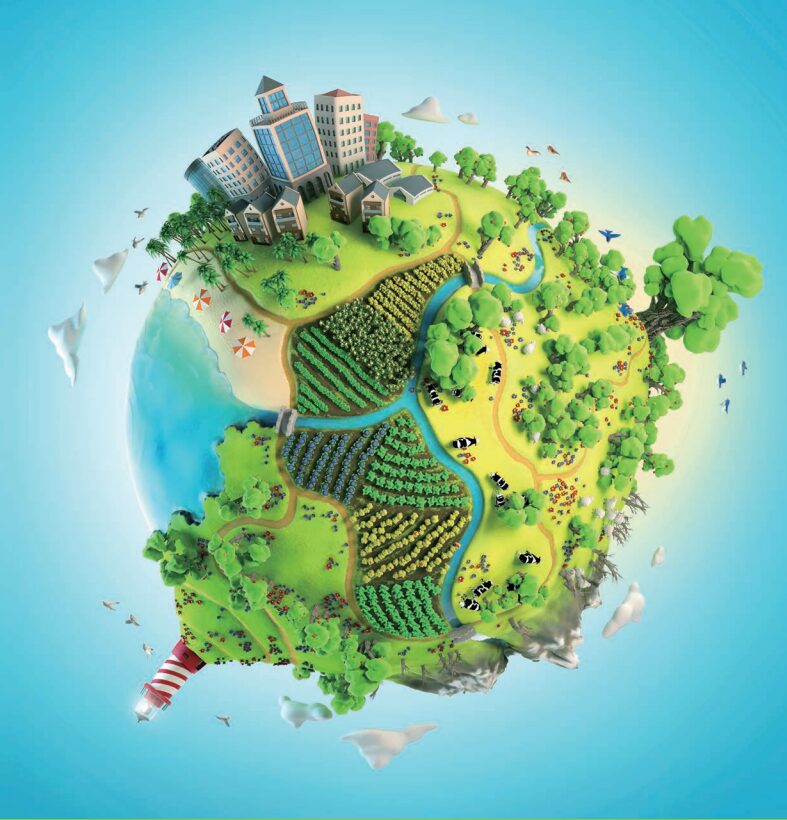

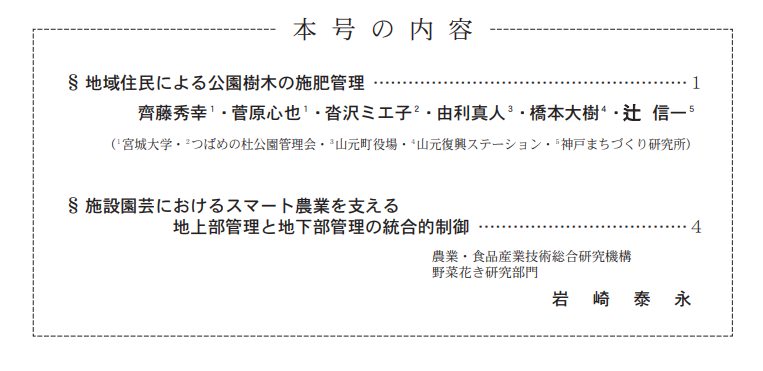
Fertilization management of park trees by local residents
Hideyuki Saito1 , Shinya Sugawara1 , Mieko Kutsuzawa2
Masato Yuri3 , Hiroki Hashimoto4 , Shinichi Tsuji5
(1 Miyagi University, 2 Tsubame no Mori Park Management Association, 3 Yamamoto Town Hall, 4 Yamamoto Reconstruction Station, 5 Kobe City Planning Institute)
Introduction
In late March 2016, five years after the Great East Japan Earthquake, Tsubame no Mori Central Park (Yamamoto Town, Watari County, Miyagi Prefecture) was opened. The park is a lush green park with a lot of playground equipment, and each entrance and exit is planted in consideration of spring, summer, fall, and winter (Figure 1). In March 2017, the following year, the "Tsubame no Mori Park Management Association" (hereafter, "Park Management Association") was established by volunteer residents mainly from the Tsubame no Mori area (about 20 members), with the aim of improving the park through collaboration between residents and the government. While inspecting playground equipment and picking up trash as part of their activities, some residents voiced their concern that the trees in the park lacked vigor.

2. survey of trees (vigor) in the park
A preliminary survey was conducted on August 22, 2017, and a full visual vigor survey of all 156 trees in the park was conducted on August 27, 2017. The results of the preliminary survey indicated that none of the trees were considered to be fully grown, and all were considered to be weakened to varying degrees (Photo 1).
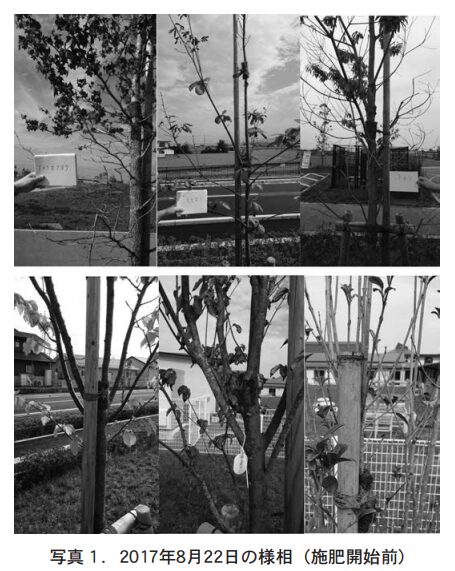
Some of them were already partially or completely dead. It seemed that some of the branches were allowed to die in order to concentrate the surviving parts (the parts with leaves) in a certain area within the same tree for the sake of survival. This was thought to be a device to prevent the dispersion of nutrients. Therefore, in the August 27th survey, we classified the vigor of the trees into three levels.
That is, as shown in Figure 2.
(1) dead (not a single leaf, twig breaks without squeezing), (2) dead (not a single leaf, twig breaks without squeezing), (3) dead (not a single leaf, twig breaks without squeezing), (4) dead (no leaves)
Weak (barely any leaves left, about to wither)
(iii) Insufficient growth (leaves but poor color, branches not spreading)
The three levels were indicated by wrapping red, yellow, and green tape around the trunk, respectively.
As a result, the
1) dead; 23 trees (15%),.
(2) Weak; 103 (661 TP3T),.
(iii) Poor growth; 30 (19%)
Table 1).


3. fertilizer management in 2017
As a result of the survey, it was feared that if no action was taken, the vigor of the tree would weaken further, which would affect overwintering, and so it was decided to urgently manage the fertilizer. The topsoil (5 to 10 cm deep) was found to be deficient in each fertilizer component, but excessive in calcium (Table 2). This may be due to the effect of soil improvement after the earthquake.

Liquid fertilizer (61 TP3T nitrogen, 101 TP3T phosphate, 51 TP3T potash, and trace amounts of bitter soil, manganese, and boron) at 500 times was applied six times on September 5, 16, 19, 26, October 3, and 10. The spraying was done in collaboration with members of the park management association and town staff. Normally, a dilution of 250 times is the standard for garden trees, but considering the fact that fertilizer absorption was declining, a thinner dilution was used and the number of applications was increased.
4. 2018 fertilizer management
Last year, first aid was provided by the Park Management Association, but in 2018 fertilization was managed by the town based on soil analysis results (Table 2). The fertilizers used in the fertilization included a drench fertilizer (Green Pile by Jaycam Agri Co.) and slow-release fertilizers (nitrogen 10%, phosphoric acid 10%, potash 10%, and bitter soil 1%). Fertilizer was applied in early May.
5. results of fertilizer management over the year (August 27, 2017 - August 26, 2018)
In the August 27, 2017 survey, (1) dead; 23 (15%), (2) weak; 103 (66%), (3) poor growth; 30 (19%), but one year later on August 26, 2018, (1) dead; 25 (16%), (2) weak; 68 ( 44%), and 3) poor growth; 60 trees (38%) (Table 1). The number of plants in (1) increased by only 11 TP3T, while the number of plants in (3) increased by about 201 TP3T. In short, many of the "weak" stage in (2) were promoted to (3) "poor growth".
6. fertilizer management in 2019
The condition of the tree on May 5, 2019 was as shown in Photo 2. The green color has become darker, and the vigor of the tree seems to have recovered. Fertilizer management by the town is continuing this year; granular organic 1001 TP3T fertilizer (61 TP3T nitrogen, 61 TP3T phosphate, and 41 TP3T potash) was applied on or about January 20.
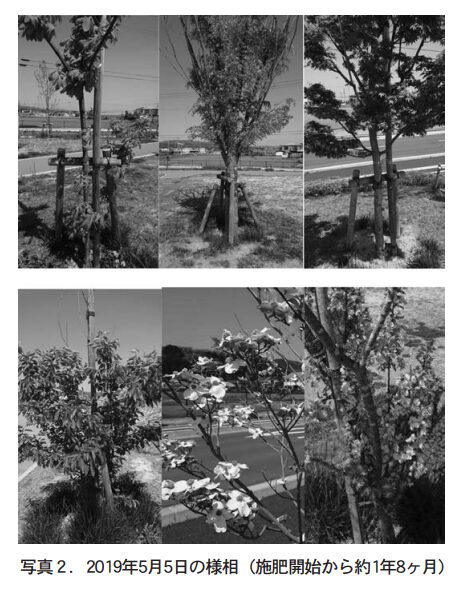
7.まとめ
Many trees are planted in parks, but in most cases, the soil environment is not conducive for them. In many cases, it is difficult to say that proper fertilizer management is being carried out. However, in this park, the enthusiastic efforts of local residents and the support of the town have been effective, and the trees are recovering their vigor.
Supporting Smart Agriculture in Facility Horticulture
Integrated control of above-ground and underground management
National Agriculture and Food Research Organization
Vegetable and Flower Research Division
Yasunaga Iwasaki
Introduction
Interest in environmental control technology to maintain CO2 concentration, temperature, humidity, air flow, and other factors in the optimal range for crop growth is rapidly increasing in the field of institutional vegetable production, and many institutions and private companies are conducting research, technology development, and product development on environmental control. However, only 2.51 TP3T of the total cultivated area in Japan is equipped with a complex environmental control system (Fig. 1). The primary objective of the Tsukuba Research Station of the Vegetable and Flower Research Division of the National Institute of Agrobiological Sciences (NIH) is to promote the widespread use of environmental control technology at production sites by clarifying the theory and specific methods of environmental control technology, thereby improving productivity, increasing growers' profits, and strengthening competitiveness.

The Ministry of Agriculture, Forestry and Fisheries (MAFF) has established 10 hectare-scale demonstration facilities throughout Japan as part of its "Project to Accelerate the Introduction of Next-generation Horticulture" (Figure 2) to demonstrate and establish a Japanese model of horticulture that utilizes employment to expand the scale of production and makes effective use of local energy.

On the other hand, research on nutrient solution cultivation was active in the 1990s, and a wide variety of research was conducted on the development of nutrient solution cultivation systems such as rockwool and NFT, medium, culture medium formulation, circulation of culture medium, and sterilization of culture medium. However, at present, there are very few examples of research and development of new products. In essence, environmental management as aboveground management and culture medium management as belowground management mutually influence each other, so if environmental conditions change, culture medium management should be changed accordingly. In the next-generation horticultural facilities, with the exception of a few, liquid culture has been introduced, and there is room for improving yield and quality by comprehensively optimizing environmental management and culture medium management together.
In this section, we will consider environmental control and the development of hydroponics technologies that may be necessary in the future from this perspective.
2. utilization of ICT and AI
The National Institute of Agro-Environmental Sciences (NIAS) has been developing an environmental control system using the Ubiquitous Environmental Control System (UECS, http://www.uecs.jp). UECS is an open standard for environmental control systems for horticulture, and a major feature of UECS is that sensors and control devices using the UECS standard can exchange data even if they are from different manufacturers. The main feature of UECS is that data can be exchanged among sensors and control devices that adopt the UECS standard, even if they are made by different manufacturers. The National Institute of Agro-Environmental Sciences (NIED) is developing a UECS-based environmental control system in cooperation with private companies (Figure 3).
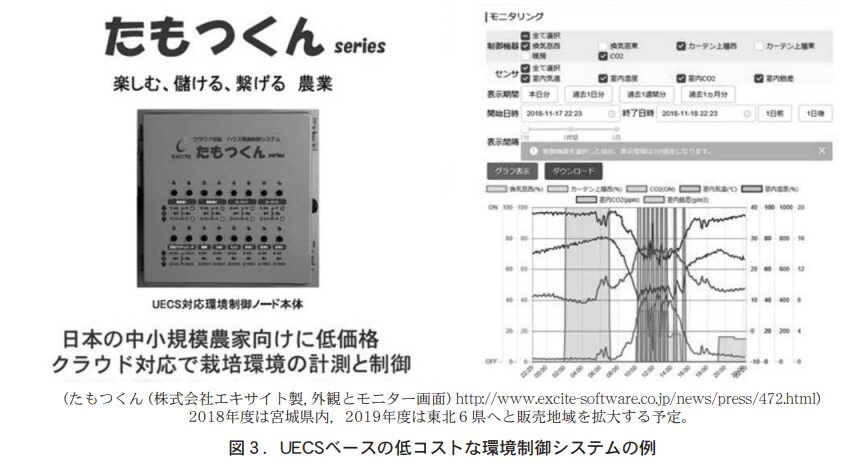
With the availability of inexpensive cloud-based environmental monitoring systems, it has become extremely easy to collect information on the growing environment, such as temperature, humidity, and CO2 concentration. On the other hand, there is no fixed method for utilizing these data, and many production sites continue to go through a trial-and-error process. The Miyagi Prefectural Institute of Agriculture and Horticulture has proposed a method of compiling environmental and growth information into a weekly report and reflecting it in environmental control settings (Figure 4).
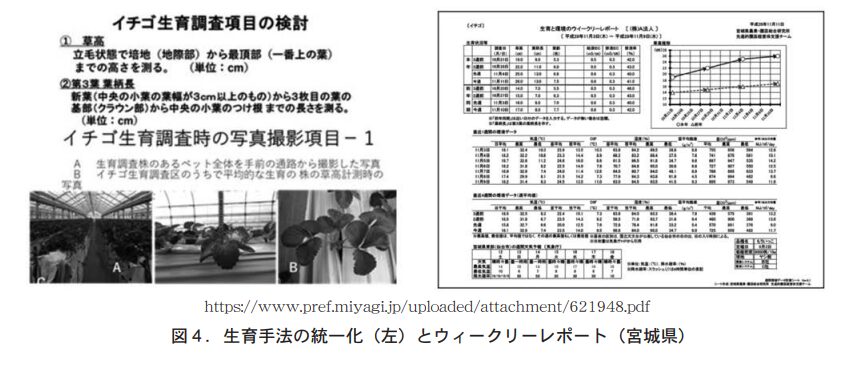
This method has been used at many production sites in Miyagi Prefecture. Recently, several producers have formed a group, sharing information within the group and using it to accumulate know-how. Easy collection and accumulation of environmental data
While the collection of growth data has become possible, the collection of growth data is still mainly done by manual growth surveys, and the collection of growth data has become a major burden in production sites (Figure 5).
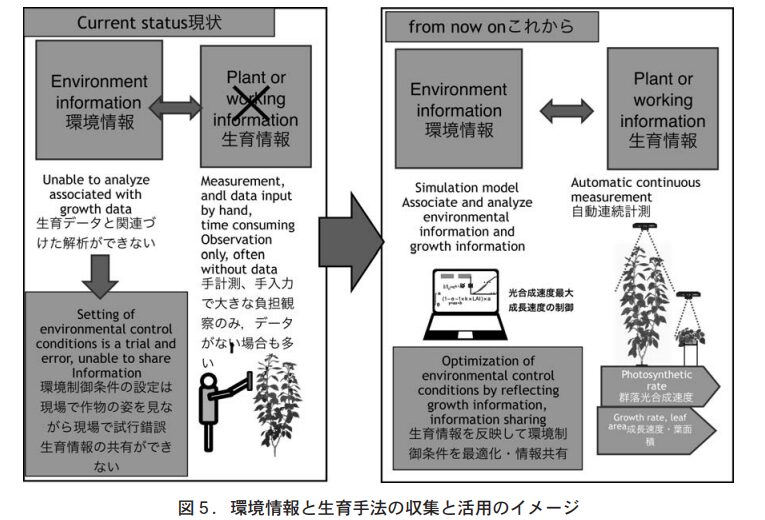
In reality, there are many cases where there are no numerical data, only observations. Furthermore, even when environmental data and growth data are collected, there is no established method for analyzing the relationship between the two. To decipher the relationship between the two, we tend to rely only on "intuition and experience. The authors have developed a 3D shape
We are developing a non-contact, continuous collection system for leaf area and grass height in crop communities using a sensor (KINECT) (Figure 6).
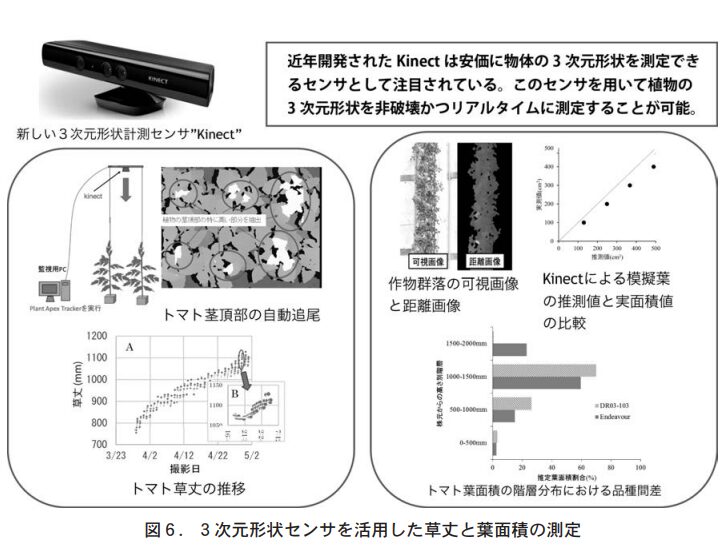
A method for estimating nutrient status in three dimensions and automatically measuring the number of flowers and fruit set is also being developed at the same time. Once such systems are available in the field, the collection of growth information should be greatly enhanced. We are also developing a growth simulation model to analyze environmental and growth data (Figure 7). If environmental management and growth information can be automatically collected and used for subsequent management, and if information can be accumulated and shared for mutual use, the value of this information will greatly increase, and the collection and accumulation of this information will further advance (Figure 8).

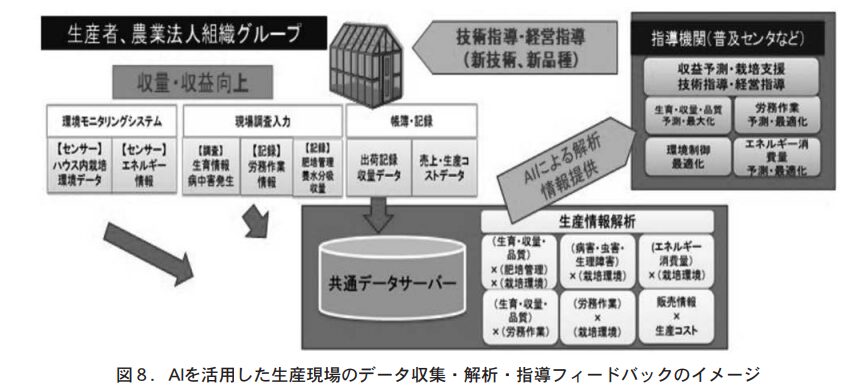
3. environmental management and culture medium management
For a crop to grow normally, the nutrient content, especially nitrogen concentration, must be maintained within a certain range. Therefore, as photosynthesis increases, nutrient requirements increase correspondingly, and if yield increases with CO2 application, fertilizer application must be increased accordingly. Maruo et al. (2001) advocated a low-concentration, daily-rate management system in which irradiation is integrated and nutrients are applied on a daily basis in proportion to the integrated irradiation. If CO2 application increases photosynthesis, the nutrient supply must be increased accordingly, otherwise the nutrient content will decrease (Fig. 9), resulting in growth retardation and susceptibility to disease.

It is known that there is a proportional relationship between leaf nitrogen concentration and photosynthetic rate per unit leaf area (Makino & Mae, 1994, Fig. 10), and CO2 application cannot be expected to be effective in crops under nitrogen-deficient conditions. In other words, nutrient management should be optimized according to solar radiation and CO2 concentration.
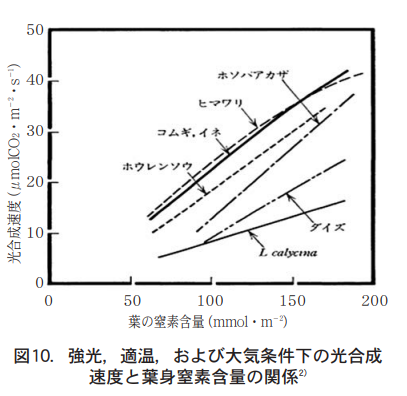
4. sink-source balance control
In the cultivation of fruit and vegetable crops, it is important to maintain moderate grass vigor throughout the growing season, and for this purpose, it is necessary to adjust the sink-source relationship to an appropriate range. Even if the amount of photosynthesis (source intensity) increases, the yield will not increase unless the number of flowers and other factors such as photosynthetic product "sink intensity" are increased accordingly. If photosynthetic output continues to be excessive (excess source intensity), grassiness will become stronger, and the plant will tend toward nutrient growth, resulting in delayed flower bud differentiation and more malformed fruit. Conversely, under-sourcing of photosynthesis results in a weakening of grass vigor, a decrease in leaf area, and lower yields. Sink intensity is often regulated by controlling the average temperature. Newly emerged new leaves also function as sinks, so increasing average temperatures speeds up leaf development and increases sink intensity in the short term.
In the past, when environmental control techniques and knowledge were not common, grass vigor and the balance between nutrient and reproductive growth were
The control has been based solely on nutrient and water management. For example, when tomatoes are cultivated in soil, water is not applied immediately after planting to suppress the absorption of fertilizer and avoid excessive nutrient growth. Photosynthetic output is mainly determined by the amount of light received, CO2 concentration, and leaf area. The regulation of nutrient supply has been done by regulating photosynthesis (source intensity) through the regulation of leaf area, and thus regulating grass vigor. The "quantitative management" of nutrient supply proposed by Nakano et al. (2006) is meant to limit nitrogen supply on a daily basis and regulate leaf area (Figure 11).

In general concentration management (EC management), it is difficult to control nutrient absorption because the rate of nutrient absorption varies with transpiration rate and irrigation frequency. Quantitative management controls the amount of light received by limiting the expansion of leaf area, regulating photosynthesis, matching sink and source intensities, and at the same time increasing the fruit distribution rate by distributing the photosynthetic products invested to produce new leaves to the fruit. However, concentration control (EC control) is still commonly used in hydroponic cultivation. Recently, in addition to regulating average temperature, techniques to regulate sink-source balance by leaf plucking and additional lateral branch elongation are becoming more common. Combining these techniques with leaf area control by nutrient supply (mainly nitrogen) may provide more efficient regulation of sink and source strength.
5. culture medium management under semi-closed management conditions
Semi-closed management is a basic approach to environmental control in which ventilation is suppressed as much as possible during the daytime, and CO2 concentration and humidity are maintained within a range suitable for crop growth by using CO2 supply equipment and fog generators. By setting higher ventilation start temperatures for skylights and side windows, controlling ventilation by using shading/heat shielding materials (films, curtains, paints) and heat pumps for cooling operation, and maintaining higher humidity, stomatal opening is increased, CO2 concentration in leaves is raised, and photosynthesis rate is increased. Since excessive transpiration is suppressed, water stress is alleviated and cell enlargement is promoted, leading to an increase in leaf area, which increases light reception and photosynthesis, or an increase in growth rate and yield (Iwasaki et al., 2011, Figure 12).

On the other hand, the transpiration rate from leaves decreases, leading to a decrease in the rate of water absorption from the roots, which may result in a shortage of fertilizer components absorbed together with water (Suzuki et al., 2015, Figure 13). In other words, under semi-closed management conditions, humidity needs to be regulated to maintain transpiration rate within an appropriate range, and at the same time, culture medium concentration and composition need to be optimized; however, to date, culture medium management suitable for semi-closed management has not been clarified.

In cold climates, however, the temperature inside the greenhouses does not rise during the winter due to low solar radiation and low outdoor temperatures, resulting in little ventilation during the daytime. The humidity inside the greenhouses increases easily both at night and during the day, and nutrient deficiencies are likely to occur due to reduced evapotranspiration. In the past, tomatoes and cucumbers were planted twice a year in such areas, and in many cases, there were no crops in the greenhouses during the severe winter season. Recently, large-scale corporate farms in such areas have begun to introduce an annual, long-duration cropping system in which crops are planted in the fall, over-wintered, and harvested until early summer of the following year, and similar problems are becoming apparent.
Nakano et al. (2015) compared the exit rate of conduit liquid coming out of the cut end of a Dutch and Japanese cultivar grown in nutrient solution after cutting the above-ground portion at the time of 7th flower cluster flowering, and reported that the Dutch cultivar had significantly higher Ca concentration in the exit liquid. Because the Netherlands receives less solar radiation than Japan, ventilation through skylights tends to be lower. As a result, the humidity in the greenhouses is likely to remain high, and varieties that can absorb nutrients under high humidity and low transpiration may have been selected.
6. Conclusion
In the past, temperature settings for skylights and heaters were often determined according to local practices. Recently, with the spread of knowledge and technology for environmental control in production, there are many cases where settings are intentionally determined, such as changing the temperature setting to adjust the growth rate. On the other hand, the amount of fertilizer applied and the amount of nutrients supplied are probably still determined according to conventional practices in both soil cultivation and hydroponics. Techniques for predicting crop growth and yield based on solar radiation and temperature are also being developed. Tools are being developed to estimate leaf area, photosynthesis, and yield from solar radiation, temperature, and fertilizer application (first of all, nitrogen supply), and to consider optimal environmental control and culture medium management.
Bibliography
(1) Maruo, T., Hoshi, H., Hohjo, M. et al. (2001):Acta Hortic. 548: 133-140.
(2) Makino, Shu and Tadahiko Mae (1994): Chemistry and Biology, VOL.32:409-413.
(3) Nakano Y., Watanabe S., Kawashima H., et al. (2006) :Zonogaku Zasshi 75 (5) : 421-429. 2006.
(4) Yasunaga Iwasaki, Shin-ichi Miura, Yusuke Otsuki (2011) :Sonogakken 10 (Supplement) 2:455.
5) Suzuki, M., Umeda, H., Matsuo.S., et al (2015) : Scientia Horticulturae,187, 44-49.
6) Nakano, A., Ando, H., and Higashide, T. (2015) :Vegetable Tea Research Report. , 14, 57-63